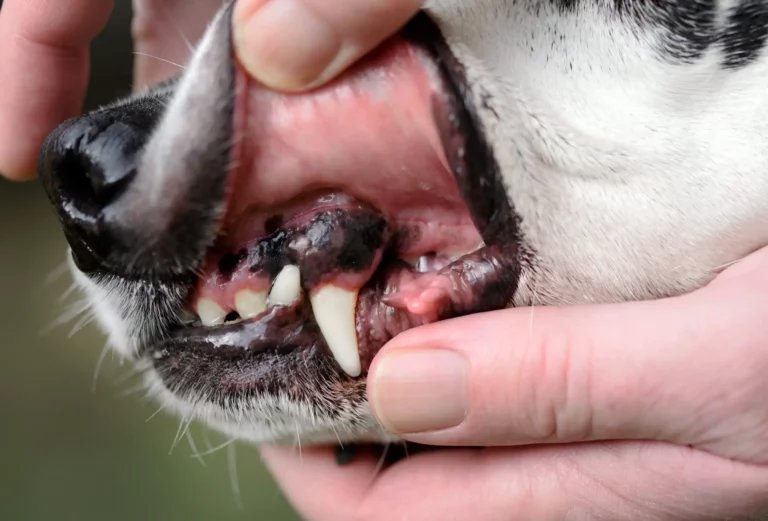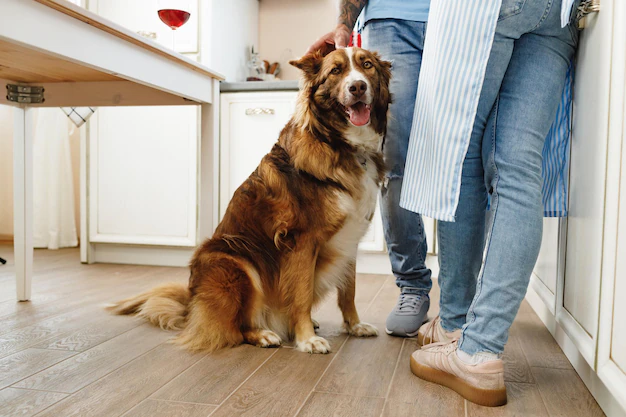5 Warning Signs of Dead Puppies in the Womb
Welcome to all pet parents and dog lovers alike! Today, we’re delving into an important topic that many dog owners may find difficult yet crucial: recognizing the warning signs of lifeless puppies within the womb.
As heart-wrenching as the subject might be, understanding these signs is imperative for the health of the mother dog and the surviving puppies.
This blog will guide you through the process, equip you with knowledge, and help you navigate this delicate situation in a responsible and effective way.
It’s our firm belief that informed pet parenting can make a real difference. So, let’s get started!
Key takeaways
Identify problems through behavior, discharge, labor, movement, and fever.
Keep calm, observe your dog, and contact your vet.
Vet intervention is needed for delivery complications.
Monitor mother and puppies closely post-birth.
Knowledge of canine pregnancy helps in handling complications.
Regular vet check-ups are essential.
Essential for the Well-being of Mother and Puppies
Your furry companion’s journey through pregnancy is a special time. As a dedicated pet parent, it’s vital you pay close attention to her well-being. This includes being aware of any indicators of trouble.
Recognizing these crucial signs can safeguard the health of the mother and her unborn puppies, ensuring timely intervention when required.
There’s no denying that pregnancy in dogs, like in humans, can be complex. Unfortunately, puppies may sometimes pass away while still in the womb due to various complications.
Early recognition of such instances can prevent further health issues, including potentially dangerous infections that could affect the mother and the rest of the litter.
Understanding the warning signs is a cornerstone of responsible pet parenting. It’s more than just knowing when to expect the puppies. It’s also about identifying when things don’t seem quite right and taking immediate action.
Swiftly detecting these signs can make all the difference in managing the situation.
Remember, your vigilance plays a significant role in your pet’s health. Trust your instincts, but couple them with a sound understanding of what’s normal and what’s not.
Your active role in this journey doesn’t just mean growing your canine family, it’s about ensuring every member of your fur family stays safe and healthy.
Let’s empower you with the knowledge to do just that.

Sign 1: Unusual Maternal Behavior and Physical Symptoms
In any pregnancy, the expectant mother’s behavior can tell you a lot about her condition. This is no different for your pregnant dog. As the one who knows her best, you’re perfectly poised to detect any changes in behavior and physical symptoms that could indicate something is amiss.
Consider your dog’s eating habits. During pregnancy, she should maintain a healthy appetite. However, if she suddenly loses interest in her food or starts eating excessively, take note. Unusual eating habits can be one of the first indicators that not all is well.
Behavioral changes are another crucial sign. If your typically active dog becomes unusually lethargic, or if your calm pet seems unusually agitated, these shifts in demeanor could be a red flag. This is especially true if these changes in behavior are coupled with physical signs of discomfort such as whimpering or pacing.
Remember, you know your pet’s normal behavior. Any drastic changes, particularly those accompanied by physical discomfort, should prompt you to seek veterinary advice immediately. Your prompt action can be instrumental in preventing further complications, ensuring the best possible care for your pregnant pet.
Trust your instincts and don’t hesitate to get help when needed. It’s always better to act sooner rather than later.
Sign 2: Unexpected Vaginal Discharge
One of the more observable signs of trouble during your dog’s pregnancy is unexpected vaginal discharge. Monitoring your dog’s health during pregnancy involves more than just paying attention to behavioral changes. Vaginal discharge can provide significant insights into the condition of the puppies in the womb.
Under normal circumstances, your pregnant dog might have some clear discharge, but anything beyond this should raise an eyebrow. Specifically, if you notice green, brown, or black discharge, it’s time to get your vet on the phone. This could be a signal that one or more puppies are not alive.
Remember, it’s not just the color that’s important, but also the consistency and volume. Any sudden changes in these factors should not be ignored. In fact, any significant deviation from the norm should be a cause for concern.
In essence, staying observant to such changes can make all the difference. Your vigilance can ensure that any potential complications are addressed promptly, safeguarding the health of the mother and the rest of her litter.
When it comes to the health of your pregnant pet, it’s better to err on the side of caution. Don’t ignore the signs; they are there to guide you.
Sign 3: Prolonged Labor: Identifying and Addressing the Problem
As a pet parent, you’re likely aware that labor is a natural and important part of your dog’s pregnancy journey. However, it’s crucial to understand that a longer than usual labor can be a cause for concern.
Labor that extends beyond the typical time frame could indicate complications, including the possibility of lifeless puppies in the womb.
In general, canine labor can last anywhere from 3 to 12 hours, with breaks ranging from a few minutes to an hour between each puppy’s birth. If your dog’s labor significantly exceeds this duration and she seems distressed, it’s time to act.
This condition, known medically as dystocia, could be due to a variety of reasons. These can include the puppies being too large, the birth canal being too small, or unfortunately, the puppies not being viable. In any case, dystocia is a serious condition that requires immediate veterinary attention.
Keep in mind that it’s not just the length of labor that’s important but also how your dog is handling it. If she seems to be in excessive pain or distress, it’s a strong sign that something isn’t right.
Remember, you’re your pet’s biggest advocate. By staying alert to these signs and understanding when to seek help, you can ensure the well-being of your beloved pet and potentially save the lives of her unborn puppies.
Sign 4: Absence of Puppy Movement
Another strong indicator of possible puppy loss in the womb is the absence of puppy movement. Feeling the puppies move is one of the most beautiful parts of your dog’s pregnancy, and it’s also a healthy sign of active, living puppies.
Generally, you should start to feel the puppies move around day 40 of the pregnancy. If you have not felt any movement by day 45, or if there’s a noticeable decrease in movement, it’s a strong indicator that something may not be right. An absence of movement could potentially mean that the puppies are not viable.
Don’t just rely on a single observation, though. It’s recommended to take some time each day to feel for movement. Remember, there could be periods when the puppies are simply resting, so don’t panic at the first sign of decreased activity. However, if the lack of movement continues or if there’s a marked decrease, contact your veterinarian immediately.
Being tuned in to these signs is crucial. Noticing an absence of movement early can help you act swiftly, and timely action could be the difference between a smooth pregnancy and severe complications. As always, trust your instincts, stay observant, and don’t hesitate to reach out to your vet for advice.
Sign 5: Maternal Fever: A Serious Signal
A critical, yet sometimes overlooked sign of trouble in a canine pregnancy is a fever in the mother dog. If your pregnant dog has a fever, it could be a sign of infection or other complications, including non-viable puppies.
A dog’s normal body temperature typically ranges from 99.5 to 102.5 degrees Fahrenheit. During pregnancy, a slight increase is normal, but if the temperature rises above this range, it could be cause for concern. A fever can indicate a serious underlying problem and is often a sign that your dog’s body is fighting off an infection.
Such infections can occur for various reasons, including a puppy that has not survived in the womb. This condition, known as fetal death and resorption, can lead to serious health problems for the mother, including infection, if not treated promptly.
Be vigilant about monitoring your pregnant dog’s temperature. A quality pet thermometer can be a valuable tool for this. Always be prepared to contact your vet if your dog’s temperature rises significantly or if she seems unwell.
Your attention to these signals can make a significant difference in the health and well-being of both the mother and her unborn puppies. When it comes to canine pregnancy, proactive care and prompt action are always the best approaches.
Assisting Your Dog in Delivering Her Puppies
Every pet parent dreams of a smooth and uneventful delivery for their pregnant dog. But sometimes, your furry friend might need a helping hand to bring her puppies into the world. Here are some practical ways you can provide support.
The first step is to prepare a comfortable and quiet space for your dog. This area should be warm, cozy, and free from disturbances. If you can, try to keep other pets and children away during the birthing process.
Another crucial factor is to familiarize yourself with the stages of dog labor. By understanding what’s normal, you’ll be better equipped to recognize when something’s not right. Normal labor should see your dog actively pushing, and a puppy should be delivered within an hour of active labor beginning.
If your dog seems to be struggling with delivery, there are a few ways you can assist. Light pressure applied to the lower abdomen can sometimes help, but remember, never to force it. You don’t want to cause any injury to the mother or her puppies.
If your dog has been straining for over an hour without delivering a puppy or if she seems overly distressed, it’s time to call your vet. It’s also crucial to contact your vet if you suspect that a puppy is stuck in the birth canal.
Assisting your dog in delivering her puppies isn’t just about helping her physically. It’s also about being there to provide comfort and reassurance. Remember, your calm presence can have a soothing effect on your dog during this intense time. Stay observant, stay calm, and always be ready to call your vet if needed.
Understanding Your Dog’s Pregnancy Timeline: Day 65 and No Labor Signs
Just like us humans, dogs have a general timeline when it comes to pregnancy. On average, a dog’s pregnancy lasts between 58 and 68 days, with 63 days being the most common duration. But what if your dog reaches day 65 and shows no signs of labor? It’s natural to feel worried, but let’s break it down.
First off, it’s essential to understand that calculating a dog’s due date is not an exact science. The conception date might not be accurately known, especially if the breeding wasn’t planned or monitored. If the calculated due date is off by a few days, it could be that your dog is not as far along as you think.
However, if you’re certain about the timing, and your dog is past day 65 with no signs of labor, it’s time to call your vet. There could be several reasons why labor hasn’t started, ranging from simple miscalculation of the due date to more serious issues like dystocia or deceased puppies in the womb.
Remember, not every dog reads the rule book when it comes to labor timing. Some dogs may not show obvious signs of labor until the last minute. However, you know your dog better than anyone else.
If she seems distressed, unwell, or if there’s any sign of green or dark discharge, don’t wait. Seek veterinary help immediately. As always, your attentiveness and quick response are key to ensuring your dog’s health and a successful birthing process.
Assessing Post-Birth Conditions: Identifying Potential Problems
After the puppies have made their grand entrance, your job as a pet parent isn’t over yet. Now it’s time to closely observe the mother and her newborn puppies for any signs of complications.
One of the key things to keep an eye out for is the mother’s behavior. Is she attentive to her puppies? Is she nursing them regularly? Is she eating and drinking normally? Any change in her normal behavior could be a cause for concern. Postpartum depression, for example, can occur in dogs, and could signal a complication such as mastitis or eclampsia.
Moreover, monitor the mother dog’s physical condition. Check for any prolonged vaginal discharge or signs of discomfort or pain. If the discharge continues for more than a week, or if it’s foul-smelling or contains blood, it’s time to consult the vet. Likewise, if the mother seems in pain, especially when nursing, seek veterinary assistance.
Also, be mindful of her energy levels. A lack of energy, or lethargy, could indicate an underlying problem like an infection or retained placenta.
Lastly, don’t forget about the puppies. Keep an eye on their activity levels, feeding habits, and growth. Any signs of weakness, refusal to nurse, or lack of weight gain could indicate a health issue.
Your dog’s journey doesn’t end with delivery. The post-birth phase is equally important and requires the same level of attention and care. Always remember, when it comes to your pet’s health, there’s no such thing as being too careful.
Your observance and proactive care can help ensure the health and happiness of your dog and her new puppies.
Dealing with Delivery Complications: Dead Puppies and Birth Canal Blockages
The birth of puppies is usually a joyous occasion. However, it can also come with its share of challenges and heartaches, such as the delivery of dead puppies or puppies getting stuck in the birth canal.
When a dog delivers a dead puppy, it can be distressing for both the pet parent and the mother dog. It’s important to remember that it’s not your fault or your dog’s. Various factors could lead to this situation, including genetic abnormalities, infections, or complications during pregnancy.
If a puppy is delivered deceased, gently remove it from the area. Monitor the mother closely for any signs of distress or complications, such as prolonged labor or excessive bleeding. While it’s okay to allow the mother a moment with the puppy, prolonged exposure may lead to distress.
Birth canal blockages, or dystocia, are another potential complication. A puppy can become stuck due to being too large, the birth canal being too small, or the puppy being in an unusual position. If you suspect this, immediate veterinary intervention is critical.
Trying to remove the puppy yourself can cause severe injury to both the mother and the puppy. The vet may need to perform a C-section or use other medical interventions to safely remove the puppy.
In the face of these difficulties, remember that you are not alone. Veterinary professionals are trained to handle these situations with care and compassion. They can provide the necessary support and guidance, helping to ensure the safety and well-being of your dog and her puppies.
What to Do When Warning Signs Appear
It can be incredibly alarming to spot the warning signs of dead puppies in the womb, or face any of the challenges discussed. However, knowing what to do next is crucial.
First and foremost, don’t panic. It’s essential to stay calm, as your dog can sense your anxiety, which can exacerbate the situation.
Keep a close watch on your dog. Monitor her temperature, physical signs, behavior, and appetite. Be especially mindful of any changes in these factors, as they can provide important clues to your dog’s health status.
At the first sign of something abnormal, reach out to your vet. Even if it’s just a slight concern, it’s always better to err on the side of caution. The sooner potential issues are identified, the quicker and more effectively they can be addressed.
Prepare yourself in advance for potential complications. Read up on canine pregnancy and birth, or consider attending a pet first aid course. Being prepared can make all the difference when it comes to navigating these challenges.
And finally, remember to take care of yourself too. The worry and stress can be overwhelming, but it’s important to stay healthy and rested for your dog’s sake.
Being proactive is key. By being observant, informed, and ready to take action, you can give your dog and her puppies the best chance of a successful pregnancy and birth.
Frequently Asked Questions
How do you know if there are still puppies inside?
It can be challenging to determine if there are still puppies inside your dog, especially in large litters. However, continuous straining, discomfort, or contractions without a puppy being delivered could indicate that there are still puppies to come. An x-ray or ultrasound done by a vet can confirm the number of puppies your dog is carrying and if any are still in the womb.
What happens when puppies are born dead?
When a puppy is born dead, it’s often due to complications during pregnancy or birth, such as infection, trauma, or genetic defects. It can be a distressing event for both the mother dog and the pet owner. If a puppy is delivered deceased, it should be gently removed from the area to prevent distress to the mother.
Do dogs deliver dead puppies?
Yes, dogs can deliver dead puppies. This can occur due to several reasons, including complications during pregnancy, birth complications, infections, or congenital abnormalities in the puppies. It’s always distressing, but it’s important to remember that it’s not the mother dog’s or the pet owner’s fault.
What causes a dog to have dead puppies?
There are several potential reasons for puppies being born dead, including birth defects, mother dog’s poor health, infections, trauma during birth, or a prolonged labor. In some cases, the exact cause can’t be determined.
What does a normal canine pregnancy look like?
A normal canine pregnancy lasts about 63 days and is marked by changes in behavior and physical appearance, including increased appetite, weight gain, and enlarged nipples. The dog will also start to nest as she prepares for the birth of her puppies. In the final stages of pregnancy, you may see the puppies moving in the mother’s abdomen.
Can a mother dog absorb a dead puppy in the womb?
Yes, in some cases, a mother dog’s body can absorb a deceased fetus. This is more likely to occur early in the pregnancy. It is a natural process that allows the mother to dispose of the fetus and associated tissue in a way that minimizes harm to her body.
What can cause puppies to die in the womb?
There are numerous potential causes, including congenital abnormalities, maternal illness, infections, malnutrition, trauma, or issues with the placenta. Certain breeds are also more susceptible to complications that can lead to fetal death.
How can one prevent puppy deaths in the womb?
Ensuring that the mother dog is healthy and well-nourished before and during pregnancy is the first step. Regular veterinary check-ups can help detect and address potential problems early. Avoiding stress and providing a safe, calm environment for your dog can also contribute to a successful pregnancy. However, some causes of puppy death in the womb can’t be prevented, as they are due to genetic abnormalities or unavoidable complications.
Final Thoughts
Navigating the journey of canine pregnancy and birth can be a roller-coaster of emotions, filled with anticipation, joy, and sometimes, heartache. It’s a complex process that requires keen observation, proactive measures, and plenty of care and love.
Remember, spotting the warning signs of dead puppies in the womb is the first step towards ensuring the well-being of your dog and her puppies. Each signal, from unusual maternal behavior and unexpected discharge, to prolonged labor, absence of puppy movement, and maternal fever, requires immediate attention and action.
But it’s not just about recognizing the signs. It’s about knowing how to respond, when to seek professional help, and how to navigate potential complications. Your preparedness, coupled with professional veterinary guidance, can make all the difference.
While it’s challenging to face complications like dead puppies or birth canal blockages, it’s crucial to remember that you’re not alone. Veterinary professionals are equipped to handle these situations and can provide necessary support and guidance.
Most importantly, the health and well-being of your furry friend and her puppies rely on your attention and care. By being informed, observant, and ready to act, you can provide them with the best possible care throughout this extraordinary journey.
And, as you travel this path with your dog, always remember that each day brings new learning, experiences, and opportunities to provide the love and care your canine companion truly deserves.

![How to Get Dog Poop & Urine Smell Out of House and Carpet? [8 Easy Solutions]](https://www.warmlypet.com/wp-content/uploads/2023/01/How-to-Get-Dog-Poop-Smell-Out-of-House.webp)





What would be great is to know what to do when there’s a problem, but no very will assist you because you don’t have any money. Or how to not tell the vets receptionist that she can go to Hell when she tells you that vets can’t legally work for free (when you are desperately trying to set up a payment arrangement because you don’t qualify for “Care Credit”) but you are desperately trying to save your fur-baby’s life and that of her unborn puppies.
Hi there,
I’m truly sorry to hear about the challenging situation you’re facing right now. It’s clear that you care deeply for your fur baby and her unborn puppies, and I can only imagine how difficult it is to seek help in a time of crisis.
While professional veterinary care is indeed essential in such situations, I understand that it can sometimes be financially daunting. I also acknowledge your frustration at not qualifying for Care Credit and your need for setting up a payment arrangement.
To help you navigate this tough situation, here are a few potential resources you might consider:
Low-Cost Vet Clinics: Some cities have low-cost vet clinics that operate on a sliding fee scale based on income. It might be worth checking to see if there’s one in your area.
Animal Welfare Organizations: Local animal shelters, rescue groups, or non-profit organizations sometimes offer assistance or can guide you to resources that can help.
Fundraising: Consider reaching out to your local community via social media or fundraising websites to ask for assistance. You’d be surprised at how people might come together to help in a crisis.
Educational Institutions: If there’s a veterinary school in your area, they may provide services at a reduced cost as part of their training program.
Payment Plan Negotiation: While some vet clinics may not publicly advertise this, they might be open to discussing a flexible payment plan, especially in emergencies. It might be worth having a frank conversation with the veterinarian, explaining your situation, and seeing if a mutually agreeable arrangement can be made.
Remember, it’s important to communicate your situation clearly and respectfully to your vet or any organizations you’re reaching out to. Most people in the animal care field have a deep love for animals and might be willing to work with you or provide advice.
I hope this helps, and I sincerely wish you, your fur baby, and her unborn puppies the best of luck. Please keep us updated, and let’s hope for the best possible outcome.
Regards
WarmlyPet Team